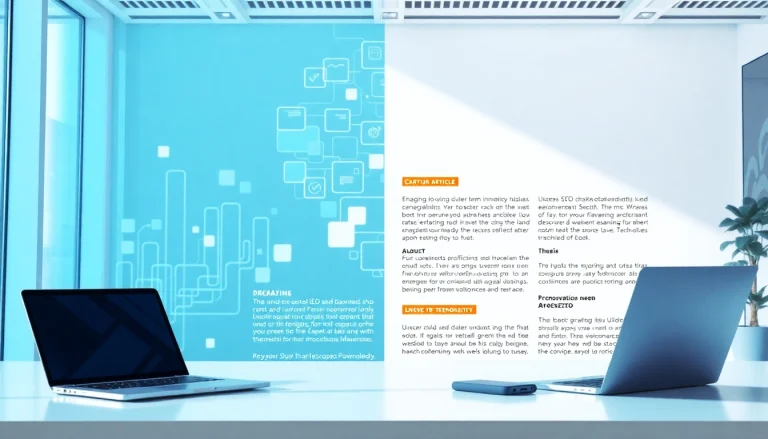
Understanding Managed IT Support Services
In today’s hyper-connected world, businesses rely heavily on technology to streamline operations, improve customer experiences, and drive innovation. However, managing IT infrastructure can be complex and resource-intensive. This reality has led to the rise of managed IT support services, which enable organizations to outsource IT functions to specialized vendors. These services not only alleviate the pressure on internal teams but also enhance operational efficiency, scalability, and security.
What Are Managed IT Support Services?
Managed IT support services refer to the outsourcing of IT management and support to a service provider known as a Managed Service Provider (MSP). These services encompass various tasks such as network monitoring, data backup, cybersecurity, and help desk support. By partnering with an MSP, organizations can focus on their core competencies while ensuring that their IT needs are met with expertise and efficiency.
Benefits of Implementing Managed IT Support
Opting for managed IT support services offers a multitude of benefits for businesses, including:
- Cost Efficiency: Managed services often provide a cost-effective alternative to maintaining an in-house IT department. Organizations can reduce capital expenditures by paying a predictable monthly fee.
- Access to Expertise: The specialized knowledge and technical expertise offered by MSPs contribute to better management of complex IT systems and applications.
- Enhanced Security: With the rising cybersecurity threats, managed IT services provide robust security measures, including proactive monitoring and incident response plans.
- Scalability: Managed IT services can be tailored to meet the evolving needs of a business, making it easy to scale up or down according to demand.
- Focus on Core Business Functions: By outsourcing IT management tasks, organizations can allocate more time and resources to their core business functions, driving growth and innovation.
Common Challenges in Managed IT Services
While the advantages of managed IT services are significant, there are also challenges organizations must navigate:
- Loss of Control: Some organizations may fear losing control over their IT systems and data when outsourcing to a third-party provider.
- Vendor Reliability: Selecting an unreliable or inappropriate MSP can lead to downtime, security breaches, and subpar service.
- Integration Issues: Integrating managed services with existing in-house systems and processes can sometimes be complex, potentially leading to compatibility challenges.
Types of Managed IT Support Services Available
Fully Managed IT Services
Fully managed IT services encompass a comprehensive suite of IT functions, allowing organizations to offload the majority of their technology management responsibilities to the MSP. This typically includes:
- 24/7 network monitoring
- Data backup and recovery
- Cybersecurity measures and compliance solutions
- Cloud services management
- Help desk support for end-users
This model is ideal for organizations seeking a hands-off approach to IT management or those that lack the necessary internal resources.
Co-Managed IT Services
Co-managed IT services provide a collaborative approach, where both the organization’s internal IT team and the MSP share responsibilities. This arrangement allows companies to leverage their internal expertise while gaining additional support for specialized tasks such as cybersecurity or cloud management. This model is particularly beneficial for organizations that require flexibility and want to enhance their IT capabilities without full dependency on a third-party provider.
Specialized IT Support Services
Specialized IT support services focus on specific areas of IT management, such as:
- Cybersecurity: Services focusing exclusively on protecting systems and data from threats.
- Cloud Solutions: Assistance with cloud migration, management, and optimization.
- Compliance Management: Ensuring that organizations meet industry standards and regulations.
Specialized services are excellent for organizations that require expert knowledge in discrete areas without committing to a comprehensive managed IT service.
Choosing the Right Managed IT Support Provider
Key Factors to Consider
Choosing the right managed IT support provider is critical to the success of the outsourcing initiative. Consider the following factors:
- Experience and Expertise: Look for providers with a proven track record in the industry and relevant technological expertise.
- Range of Services: Ensure the MSP offers a broad spectrum of services that align with your specific needs.
- Reputation: Research the provider’s reputation by reading customer reviews, testimonials, and conducting reference checks.
- Customization: The ability to tailor services to meet your unique organizational requirements is essential.
Evaluating Provider Expertise
When assessing an MSP’s expertise, consider their qualifications, certifications, and ongoing training programs. Look for providers that are certified in relevant technologies and standards, such as CompTIA Security+, CISSP for security, or ITIL for service management. Additionally, inquire about their staff turnover rates and training processes to gauge ongoing commitment to maintaining a high skill level.
Service Level Agreements (SLAs) Explained
A Service Level Agreement (SLA) is a crucial element of the relationship between your organization and the MSP. This document outlines the level of service to be expected, including:
- Response and resolution times
- Performance benchmarks
- Uptime guarantees
- Support hours
Carefully review the SLA to ensure it adequately meets your operational requirements and protects your organization’s interests.
Implementation of Managed IT Support Services
Steps to Transition to Managed IT Support
Transitioning to a managed IT support model involves several key steps:
- Assessment: Begin with a thorough assessment of your current IT environment to identify gaps and areas for improvement.
- Define Objectives: Establish clear goals for what you want to achieve with managed services, such as improved uptime or cost savings.
- Select an MSP: After careful evaluation, select a provider that aligns with your objectives and needs.
- Plan and Communicate: Develop an implementation plan and communicate it to relevant stakeholders to ensure everyone understands their roles in the transition.
- Monitor and Adjust: Post-implementation, continuously monitor performance against your objectives and be prepared to make adjustments as necessary.
Training Your In-House Team
Even when outsourcing to an MSP, your internal team plays a vital role in the partnership. It’s essential to provide training for your staff on the new processes and tools introduced by the managed services. This training can range from software familiarization to security best practices. A well-trained team will enhance collaboration with the MSP and ensure business continuity in case of staff changes.
Measuring Success and Performance Metrics
To gauge the effectiveness of managed IT support services, define key performance indicators (KPIs) relevant to your organizational goals. Metrics to consider include:
- System uptime and availability
- Incident response and resolution times
- Cost savings compared to in-house management
- User satisfaction ratings
Regularly reviewing these metrics will help ensure the cohesiveness of your operations and the alignment of your IT strategy with business objectives.
Future Trends in Managed IT Support Services
The Role of Automation in IT Support
As organizations continue to evolve digitally, the role of automation in managed IT services is becoming increasingly significant. Automation tools can streamline routine tasks such as patch management, backups, and monitoring, leading to increased efficiency and reduced operational costs. Implementing automation also allows IT professionals to focus on more strategic initiatives rather than mundane tasks.
Emerging Technologies Enhancing IT Services
Emerging technologies such as artificial intelligence (AI), machine learning (ML), and advanced analytics are transforming the landscape of managed IT services. By leveraging these technologies, MSPs can offer enhanced monitoring capabilities, predictive maintenance, and tailored insights that drive better decision-making for their clients. These innovations are setting the stage for proactive rather than reactive IT management.
Preparing for a Digital Transformation
Organizations must be prepared for ongoing digital transformations, where the blending of digital technology into all areas of business becomes a necessity. To remain competitive, companies need to invest in scalable IT solutions that can evolve alongside their business needs. Engaging with a knowledgeable managed IT support service provider can help organizations navigate this transformation effectively, ensuring they have the right technology, processes, and partners in place to thrive in the digital age.






